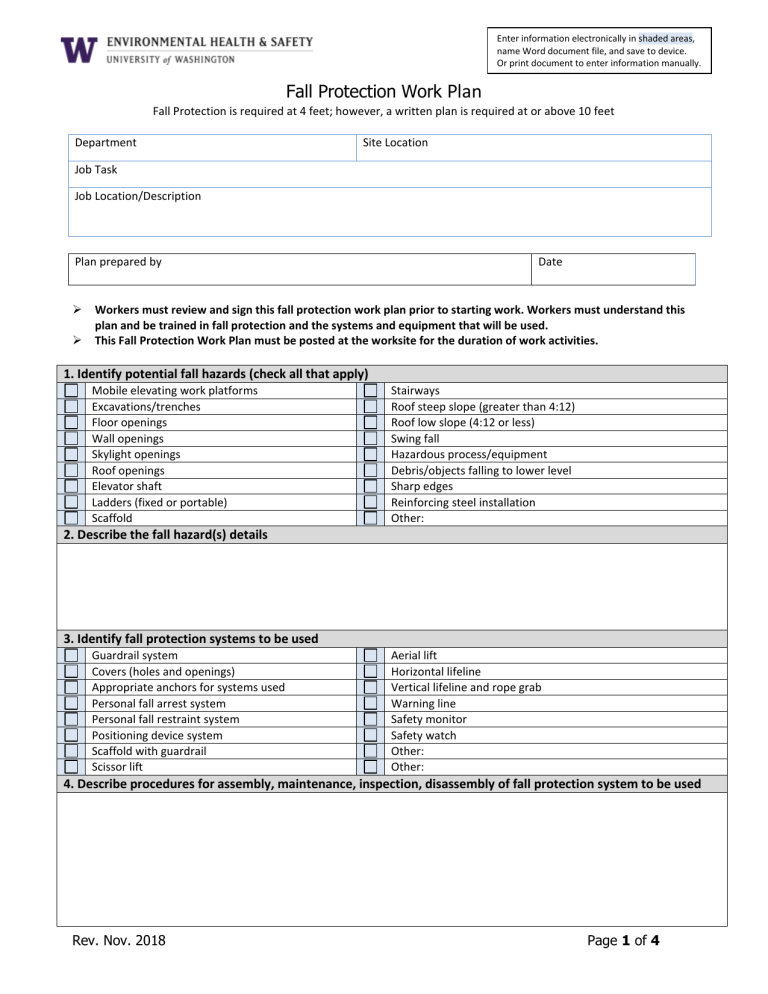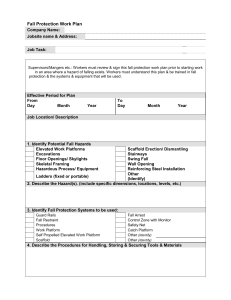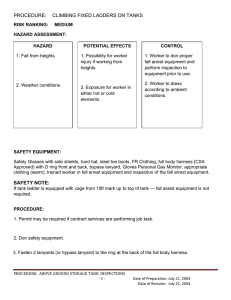
Enter information electronically in shaded areas, name Word document file, and save to device. Or print document to enter information manually. Fall Protection Work Plan Fall Protection is required at 4 feet; however, a written plan is required at or above 10 feet Department Site Location Job Task Job Location/Description Plan prepared by Date Workers must review and sign this fall protection work plan prior to starting work. Workers must understand this plan and be trained in fall protection and the systems and equipment that will be used. This Fall Protection Work Plan must be posted at the worksite for the duration of work activities. 1. Identify potential fall hazards (check all that apply) Mobile elevating work platforms Excavations/trenches Floor openings Wall openings Skylight openings Roof openings Elevator shaft Ladders (fixed or portable) Scaffold Stairways Roof steep slope (greater than 4:12) Roof low slope (4:12 or less) Swing fall Hazardous process/equipment Debris/objects falling to lower level Sharp edges Reinforcing steel installation Other: 2. Describe the fall hazard(s) details 3. Identify fall protection systems to be used Guardrail system Covers (holes and openings) Appropriate anchors for systems used Personal fall arrest system Personal fall restraint system Positioning device system Scaffold with guardrail Scissor lift Aerial lift Horizontal lifeline Vertical lifeline and rope grab Warning line Safety monitor Safety watch Other: Other: 4. Describe procedures for assembly, maintenance, inspection, disassembly of fall protection system to be used Rev. Nov. 2018 Page 1 of 4 Enter information electronically in shaded areas, name Word document file, and save to device. Or print document to enter information manually. 5. Describe procedures for handling, storage, securing tools and materials 6. Identify methods of overhead protection for workers who may be in, or pass through the area below worksite Barricading Hard hats required Catch net Warning signs Tool belts Tool lanyards Toeboards/screens on scaffolds Toeboards/covers on floor openings Screens on guardrails Secure large tools Other: Other: 7. Identify method for prompt, safe removal of injured workers CALL 911 IF FALL OCCURS Written agreement with: Self-rescue Site first aid Other employees Elevator/stairs Other: 8. Identify method used to determine adequacy of anchorage points Evaluation by professional engineer Manufacturer’s data Existing engineering/design documents Other: 9. Describe and identify locations of anchorage points 10. Select system components Full body harness Vertical lifeline Horizontal lifeline Lanyard Boatswains chair Connecting devices (identify) Choker Carabiner Rope grab Personal shock absorber Beamer Anchorage points (identify) Other: Other: 11. Distance from anchor to ground, lower level or obstruction (see page 4 chart) 12. Calculated minimum fall clearance (see page 4 chart) 13. Inspection Checklist Rev. Nov. 2018 Page 2 of 4 Enter information electronically in shaded areas, name Word document file, and save to device. Or print document to enter information manually. Identification tags Horizontal lifeline tension is correct Integrity of stitching in shock absorber Integrity of stitching in harness/lanyard Manufacturers assembly/disassembly instructions Locking capability of retractable lanyards assured Locking capability of carabiners assured Locking capability of snap hooks assured Knots and other connection methods do not weaken lifeline Lifelines installed and protected from cuts or abrasions Rope (wear, fraying, damage, mildew) Lanyards (wear, fraying, damage, mildew) D-rings have adequate strength, are not cracked or deformed Guardrails are sound and of adequate strength Devices that are used to connect to horizontal lifelines lock in both directions Anchorage points provide adequate strength and are capable of meeting requirements Hole covers are secured, marked and capable of withstanding anticipated weight loads Warning line meets strength and other requirements Safety Monitor is Competent Person, can see workers, is close enough to communicate, has no other duties Safety Watch is Competent Person, can see worker, is close enough to communicate, has no other duties Other Other 14. Employee(s) trained to work under this plan Name (print) Signature Date Name/title of Competent Person who provided training under this plan 15. Work plan approval(s) Name of lead worker or supervisor Signature Date Name of Competent Person (If engineered system: Name of Qualified Person) If administrative controls: Name of department manager Rev. Nov. 2018 Page 3 of 4 Enter information electronically in shaded areas, name Word document file, and save to device. Or print document to enter information manually. Fall clearance is the minimum vertical distance needed between the anchor point and a lower level (this can be the ground or lower obstruction) with a safety factor to prevent the worker from hitting the lower level in a fall. What is the distance from the anchor point to the ground or lower level where a worker would fall? If a worker falls, when wearing a fall protection system, what is the minimum fall clearance from the anchor point to the worker’s feet including a 3 ft. safety factor? (Calculate as shown below) The calculated minimum fall clearance of a specific fall protection system may never be equal or greater than the distance between the anchor point and the lower level. Description Lanyard length or free fall distance for selfretracting lifeline Maximum allowable deceleration distance Worker’s height Other component if applies Safety factor Minimum fall clearance (sum of above) Distance (ft.) 3 ½ ft. 3 Calculating Fall Clearance using a Shock Absorbing Lanyard Example: • First, add the length of the shock absorbing lanyard (6 ft.) to the maximum elongation of the shock absorber during deceleration (3 ½ ft.) to the average height of a worker (6 ft.) • Then, add a safety factor of 3 ft. to allow for the possibility of an improperly fit harness, a taller than average worker and/ or a miscalculation of distance. • The total, 18 ½ ft. is the suggested safe fall clearance distance for this example. NOTE: Should the shock absorbing lanyard be used in conjunction with a cross- arm anchorage connector or other, the additional length of the anchorage connector must be taken into consideration. Calculating Fall Clearance using a Self- Retracting Lifeline Example: First, add the maximum free fall distance (2 ft.) with a retractable lifeline to the maximum deceleration distance (3 ½ ft.) to the average height of a worker (6 ft.) Then, add a safety factor of 3 ft. to allow for the possibility of an improperly fit harness, a taller than average worker and/ or a miscalculation of distance. The total, 14 ½ ft. is the suggested safe fall clearance distance for this example. NOTE: When using a retractable lifeline, the distance is calculated from the point where the retractable attaches to the back D- ring of the worker’s harness. Rev. Nov. 2018 Page 4 of 4





